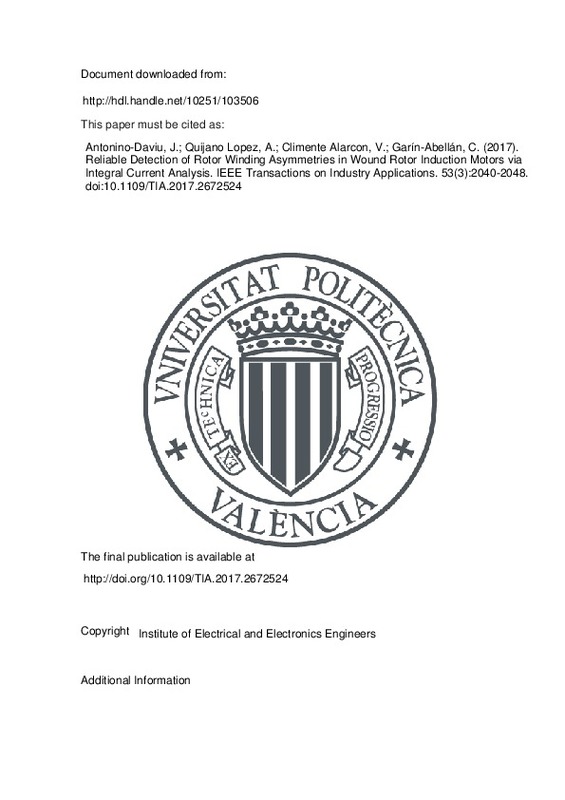Antonino-Daviu, J.; Quijano Lopez, A.; Climente Alarcón, V.; Garín-Abellán, C. (2017). Reliable Detection of Rotor Winding Asymmetries in Wound Rotor Induction Motors via Integral Current Analysis. IEEE Transactions on Industry Applications. 53(3):2040-2048. https://doi.org/10.1109/TIA.2017.2672524
Por favor, use este identificador para citar o enlazar este ítem: http://hdl.handle.net/10251/103506
|
Título:
|
Reliable Detection of Rotor Winding Asymmetries in Wound Rotor Induction Motors via Integral Current Analysis
|
|
Autor:
|

 Antonino-Daviu, J.
Antonino-Daviu, J.

 Quijano Lopez, Alfredo
Quijano Lopez, Alfredo
 Climente Alarcón, Vicente
Garín-Abellán, Carlos
Climente Alarcón, Vicente
Garín-Abellán, Carlos
|
|
Entidad UPV:
|
Universitat Politècnica de València. Departamento de Ingeniería Eléctrica - Departament d'Enginyeria Elèctrica
|
|
Fecha difusión:
|
|
|
Resumen:
|
[EN] Current analysis has been widely employed in academy and industry for the diagnosis of rotor damages in cage induction motors. The conventional approach based on the FFT analysis of steady-state current (MCSA) has ...[+]
[EN] Current analysis has been widely employed in academy and industry for the diagnosis of rotor damages in cage induction motors. The conventional approach based on the FFT analysis of steady-state current (MCSA) has been recently complemented with the development of alternative techniques that rely on the time-frequency analysis of transient quantities of the machine. These techniques may bring important advantages that are related to the avoidance of eventual false indications provided by the classical MCSA. Moreover, their application is also suitable for variable speed conditions. However, the application of current-based methodologies to wound rotor induction motors (WRIM) has been much less studied and, hence, their validation in field WRIM is scarce. The present work proposes the application of an integral methodology based on the analysis of both stationary and transient currents for the diagnosis of winding asymmetries in WRIM. The method, based on up to five different fault evidences, is validated in laboratory motors and it is subsequently applied to a large field motor (1,500 kW) that was showing signs of abnormal rotor functioning. The results prove that the method is of interest for the field since it helps to ratify without ambiguity the existence of eventual asymmetries in the rotor windings, with no interference with the machine operation. However, due to the complex constructive nature of the rotor winding as well as the presence of auxiliary systems (slip rings, brushes, contactors, etc ), once the fault presence is detected, it may be interesting the utilization of complementary tools to accurately locate the root cause of the asymmetry.
[-]
|
|
Palabras clave:
|
Induction motors
,
Wound rotor
,
Fault diagnosis
,
Transient analysis
,
Wavelet transforms
|
|
Derechos de uso:
|
Reserva de todos los derechos
|
|
Fuente:
|
IEEE Transactions on Industry Applications. (issn:
0093-9994
)
|
|
DOI:
|
10.1109/TIA.2017.2672524
|
|
Editorial:
|
Institute of Electrical and Electronics Engineers
|
|
Versión del editor:
|
http://doi.org/10.1109/TIA.2017.2672524
|
|
Título del congreso:
|
8th IEEE Energy Conversion Congress and Exposition (ECCE 2016)
|
|
Lugar del congreso:
|
Milwaukee, USA
|
|
Fecha congreso:
|
September 18-22,2016
|
|
Código del Proyecto:
|
info:eu-repo/grantAgreement/MINECO//DPI2014-52842-P/ES/COMBINACION DE TECNICAS NO INVASIVAS DE MONITORIZACION DEL ESTADO PARA EL DESARROLLO DE MOTORES ELECTRICOS INTELIGENTES/
|
|
Descripción:
|
(c) 2017 IEEE. Personal use of this material is permitted. Permission from IEEE must be obtained for all other uses, in any current or future media, including reprinting/republishing this material for advertising or promotional purposes, creating new collective works, for resale or redistribution to servers or lists, or reuse of any copyrighted component of this work in other works
|
|
Agradecimientos:
|
This work was supported in part by the Spanish Ministerio de Economia y Competitividad and in part by the Fondo Europeo de Desarrollo Regional Program in the framework of the Proyectos i+d del Subprograma de Generacion de ...[+]
This work was supported in part by the Spanish Ministerio de Economia y Competitividad and in part by the Fondo Europeo de Desarrollo Regional Program in the framework of the Proyectos i+d del Subprograma de Generacion de Conocimiento, Programa Estatal de Fomento de la Investigacion Cientifica y Tecnica de Excelencia under Grant dpi2014-52842-P.
[-]
|
|
Tipo:
|
Artículo
Comunicación en congreso
|







![[Cerrado]](/themes/UPV/images/candado.png)


